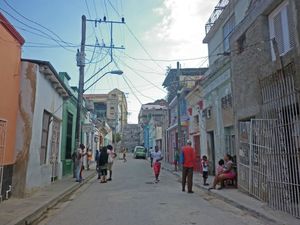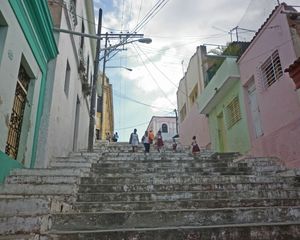

Tívoli, Santiago de Cuba
Go all over the beautiful neighbourhood of Tívoli and live its carnivals while you admire its exceptional architecture and landscapes in Santiago de Cuba.
Visit the symbolic neighbourhood of Tívoli and visit its steep streets, flanked by high houses looking at the sea, alleys and hills. Inhabited mainly by French immigrants in their fled because of the Haitian raising, the neighbourhood was created in the first half of the 17th century by the poor and creole Spaniards who came from outside.
The name is owed to a Café Concert for more than 300 people built by the French with the name Le Tívoli, which was adopted by the whole neighbourhood. The European influence can be seen in the architecture of the streets as well and in the customs and traditions of the inhabitants of the place.
Go all over the historic streets of the important neighbourhood of Santiago and go up the gorgeous stairway to the famous Trocha Street, very well-known because of the carnival festivities in which the pagan African traditions and the French saloon balls join. Do not miss the chante of witnessing the mixture of culture in this fascinating neighbourhood, where you can still see the well known dance known as French tomb along with tambourines and other African instruments.
A place that saw the birth of important Cuban musicians, its Carnival is one of the most famous ones in the area and, along with the views of the bay and the mountains, make the visit something very special, accessed through the Escalinata de Padre Pico Stairway in the Loma de Corbacho Hill. You can also find in the area the Clandestine Fight Museum (Museo de Lucha Clandestina) and the house in which Fidel Castro lived between 1931 and 1933.
More information:
Location:
Centro de Santiago de Cuba.
Interactive map:
Santiago de Cuba
What to see:
- Céspedes Park
- Calle Heredia Street
- Nuestra Señora de la Asunción Cathedral
- Velázquez Balcony
- Casa de la Trova
- Model of the City
- Plaza de Dolores Square
- Iglesia de Nuestra Señora de los Dolores Church
- Plaza de Marte Square
- Provincial Government Palace
- Tívoli
- Escalinata Padre Pico Highway
- Cuartel Moncada Headquarters
- Plaza de la Revolución
- Pioneers’ Palace
- La Gran Piedra
- Cumbre La Gran Piedra Summit
- Cafetal La Isabelica Coffee Plantation
- Parque Baconao
- Baconao Aquarium
- Baconao Lagoon
- Granma Cay
- Siboney
- El Cobre
- Nuestra Señora del Cobre Basilica
- Chivirico and its Vicinity
- Pico Turquino Peak Area
- Pico Turquino
Beaches:
Museums:
- Museum of Historical Cuban Atmosphere
- Archdiocesan Museum
- Municipal Museum Emilio Bacardí Moreau
- El Carnaval Museum
- Rum Museum
- Clandestine Fight Museum
- Casa-Natal de Antonio Maceo Birth House Museum
- Abel Santamaría Historic Park
- San Juan Historic Park and the Peace Tree
- Cemetery of Santa Ifigenia
- Castle of San Pedro de la Roca del Morro
- Granjita Siboney Museum
- Spanish-Cuban-American War Museum
- Prehistory Valley
- Monument to Cimarrón
Other nearby destinations:
Why "Trip Cuba"?
Trip Cuba is an organization of Cuban agencies whose objectives are:
- ✓ To make Cuba, its culture and its heritage known.
- ✓ To promote sustainable tourism.
- ✓ To support the local economy, prioritizing direct contact with Cuban agencies.
Travel Agencies
If you are a travel agency or tour operator and you are looking forward to any assistance or collaboration to plan trips to Cuba, rely on our extensive experience
Copyright www.TripCuba.Org © - All rights reserved
All our agencies are duly registered in the National Registry of Travel Agencies of the Chamber of Commerce of the Republic of Cuba.








